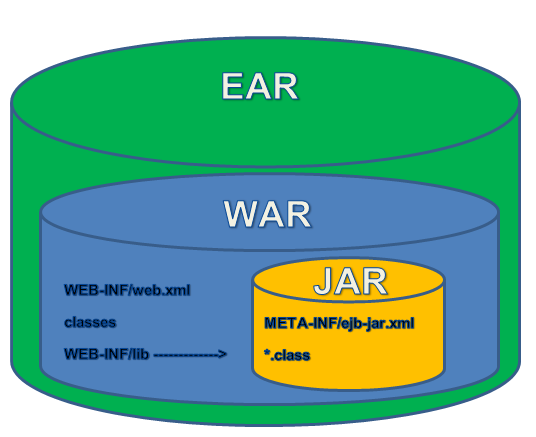In the world of Java development, application deployment is a critical step in getting software from the development environment to the production environment. One of the key components of this process is packaging the application into a specific file format. In this article, we will be discussing three popular file formats in Java: JAR, WAR, and EAR files, and understanding the basics behind their usage and purpose.

JAR (Java Archive)
JAR, which stands for Java Archive, is a package file format that is typically used to aggregate and distribute Java class files, libraries, and resources such as images or text files. A JAR file is a compressed archive file that uses the ZIP compression algorithm, and its extension is “.jar”.
JAR files can be easily created using tools such as the ‘jar’ command-line utility that comes with the Java Development Kit (JDK) or via build automation tools like Apache Ant, Maven, or Gradle. JAR files simplify the process of sharing libraries and make it easier to manage dependencies, as well as allowing for the distribution of complete applications.
Example: A standalone utility library
Suppose a team of developers is working on a utility library that provides various helper functions, such as file handling, data manipulation, and network operations. This library is not a web application, nor does it have any specific Java EE components. In this case, the most appropriate choice for packaging and distributing the library would be a JAR file. This would allow other developers to easily incorporate the utility library into their projects as a dependency.
WAR (Web Application Archive)
WAR, which stands for Web Application Archive, is a file format that is used for packaging and distributing Java-based web applications. A WAR file is essentially an extension of the JAR file format with a specific directory structure and a “.war” file extension.
The primary purpose of a WAR file is to bundle web application components such as Java servlets, JavaServer Pages (JSP), Java classes, and other resources like images, stylesheets, or JavaScript files. The structure of a WAR file includes a “WEB-INF” folder that contains critical information about the web application, such as the deployment descriptor (“web.xml”), libraries, and class files.
Java-based web applications that use WAR files are typically deployed on web containers or application servers such as Apache Tomcat, Jetty, or JBoss/WildFly, which conform to the Java EE (Enterprise Edition) specifications.
Example: A web-based task management application
Consider a project where the objective is to create a web-based task management application that allows users to create, manage, and track tasks. The application is built using Java servlets, JSPs, and a front-end framework like Angular or React. The application may also include images, stylesheets, and JavaScript files. In this scenario, the most suitable choice for packaging and distributing the application would be a WAR file. This would enable the application to be deployed on a web container or an application server such as Apache Tomcat or Jetty.
EAR (Enterprise Application Archive)
EAR, which stands for Enterprise Application Archive, is a file format that is designed for packaging and distributing Java EE applications. An EAR file is a composite of JAR and WAR files and is used for deploying multi-tier applications that consist of both web and business logic components. EAR files have the “.ear” extension and use a specific directory structure.
The structure of an EAR file includes a “META-INF” folder that contains the deployment descriptor (“application.xml”), which provides information on how the application components should be assembled and deployed on an application server. The EAR file can contain multiple JAR and WAR files, each representing different components of the Java EE application.
Java EE applications packaged as EAR files are typically deployed on Java EE-compliant application servers such as GlassFish, JBoss/WildFly, or IBM WebSphere.
Example: An e-commerce platform
Imagine a large-scale project to build an e-commerce platform that comprises various components, such as a web-based front-end for customers to browse and purchase products, a set of business logic components for processing orders, and integrations with various third-party services for payment processing and shipping. This complex, multi-tier application would require both web components (packaged as WAR files) and business logic components (packaged as JAR files). To facilitate the deployment of such a composite application, the most appropriate choice would be to package it as an EAR file. This would allow the application to be deployed on a Java EE-compliant application server such as GlassFish or JBoss/WildFly, which can handle the different components of the application and manage their interactions.
Conclusion
In summary, JAR, WAR, and EAR files are essential packaging formats in the Java ecosystem that serve different purposes. JAR files are used for bundling Java classes, libraries, and resources, while WAR files are specifically tailored for web applications. EAR files, on the other hand, are designed for packaging and deploying complex, multi-tier Java EE applications. Understanding the basics of these file formats is crucial for Java developers, as it helps streamline the application deployment process and ensures successful integration with various runtime environments.
